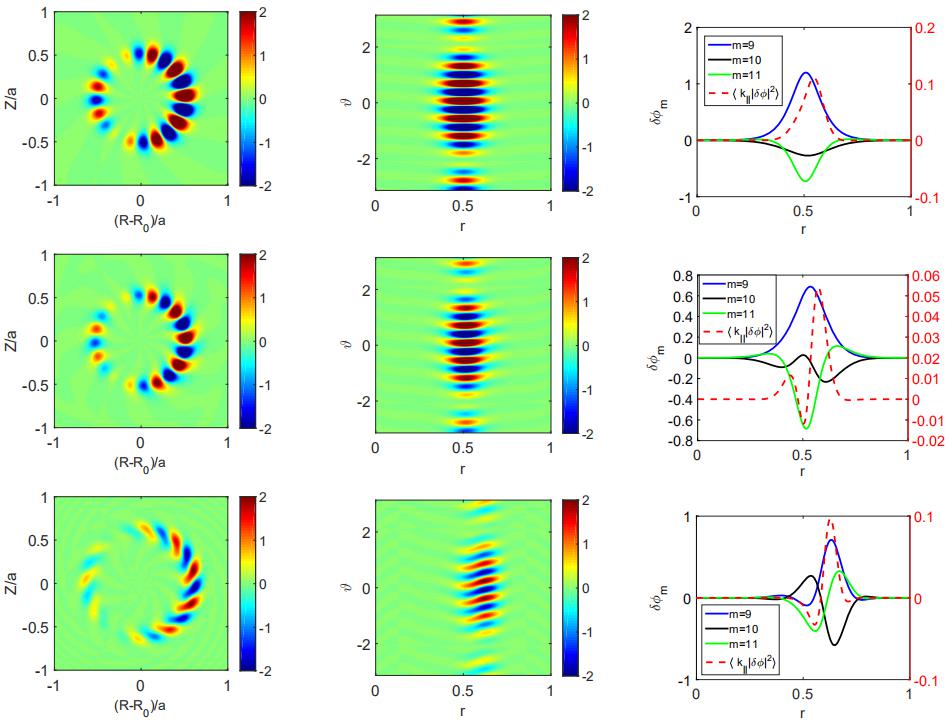Speaker
Description
Energetic particle (EP) physics in fusion research are excepted to play crucial roles in the next generation of tokamak burning plasma experiments, e.g., ITER. Energetic fusion alpha particle heating of fuel ions through collisional and collisionless channels is crucial for achieving self-sustained burning. On the other hand, free energy associated with EPs pressure gradient, can drive collective instabilities, e.g., shear Alfvén waves, via wave-particle resonance, and induce EP anomalous transport due to the breaking of toroidal symmetry. One of such Alfvén wave instabilities, which has received considerable interest, is the beta-induced Alfvén eigenmode (BAE)[1].

$\quad$BAEs have been recently observed in HL-2A during the Ohmic and ECRF heating[2]. Moreover, gyrokinetic simulations using HL-2A parameters[3] show that the precessional resonance of trapped energetic electrons (EEs) can drive BAE (e-BAE) instabilities and induce the typically observed croissant-like up-down asymmetric mode structures. To our knowledge, detailed theoretical understanding of the e-BAE physics, including the excitation mechanism, the global stability and corresponding radial mode structures as well as the e-BAE nonlinear saturation, are still lacking. On the other hand, the EE finite orbit width normalized to the minor radius of the present-day tokamaks, could be comparable to that of the alpha particles characterized by small dimensionless orbits in reactors, e.g., ITER. Thus, the in-depth understanding of the e-BAE physics based on first-principle-based theory[4] is needed, and this constitutes the main motivation of the present work.
$\quad$In this work, employing the WKB-ballooning mode representation along with the generalized fishbone like dispersion relation[5], the two-dimensional (2D) global dispersion relation of the high-n e-BAEs excited by precessional resonance of magnetically trapped EE is derived in large aspect-ratio, low-$\beta$ and low magnetic shear tokamaks with shifted circular flux surfaces. It is found that[6] the contribution of the trapped EEs to the global e-BAE dispersion relation is limited to the ideal MHD structure of the BAE due to the EE bounce averaging dynamic being governed by normal curvature. Moreover, our numerical results show that, (i) for the local properties of e-BAE: the mode can be destabilized by EEs using the typical equilibrium parameters in HL-2A, and the mode frequency is consistent with the experimental observation. Varying the background plasma parameters can lead to transitions between e-BAEs and energetic particle modes. Moreover, the dependence of the e-BAE frequencies and growth rates on energetic electron parameters shows that the growth rates monotonically increase(decrease) with the energetic electron density(the normalized energetic electron density gradient scale length), and the frequencies are not much affected. The frequency and growth rate are sensitive to the energetic electron temperature, and there exists a maximum growth rate. (ii) For the global properties of e-BAE[6], the mode is radially localized in the potential well generated by the pressure gradient of EEs, and the most unstable mode gradually changes from the highly excited state to the lowest radial bound state with the increase of the EE density. The anti-Hermitian contributions due to wave-energetic particle resonance give rise to the twisting radial mode structures, shown in Fig. 1, and the direction of deformation is opposite to that of the mode structure caused by energetic ions, which is consistent with the simulation results of GTC[3]. Moreover, the symmetry breaking of the e-BAE mode structure with respect to parallel wave-number, as shown in Fig. 1, has a potential impact on toroidal momentum transport, and is analyzed. Finally, generation of zonal flow, as a potential channel for the e-BAE nonlinear saturation, is also investigated[7].
Acknowledgment
$\quad$This work is supported in part by National Natural Science Foundation of China under Grant No. 11705050, the ITER-CN under Grant Nos. 2018YFE0304103, 2017YFE0301900 and National Natural Science Foundation of China under Grant Nos. 11875024 and 11875021.
References
[1] M.S. Chu et al., Phys. Fluid B 1992, 4, 3713.
[2] W. Chen et al., Phys. Rev. Lett. 2010, 105, 185004.
[3] Y. Chen et al., Phys. Plasmas 2019, 26,102507.
[4] L. Chen et al., Journal of Geophysical Research 1991, 96, 1503.
[5] F. Zonca et al., Phys. Plasmas. 2014, 21, 072121.
[6] R.R. Ma, et al., Nucl. Fusion 2020, https://doi.org/10.1088/1741-4326/ab7f15. R.R. Ma, et al., Global theory of beta-induced Alfvén eigenmodes by energetic electrons, in preparation.
[7] Z.Y. Qiu, et al., Zero frequency zonal flow excitation by energetic electron driven beta-induced Alfvén eigenmode, Submitted to Plasma Physics and Controlled Fusion, 2020.
| Affiliation | Southwestern Institute of Physics |
|---|---|
| Country or International Organization | China |
